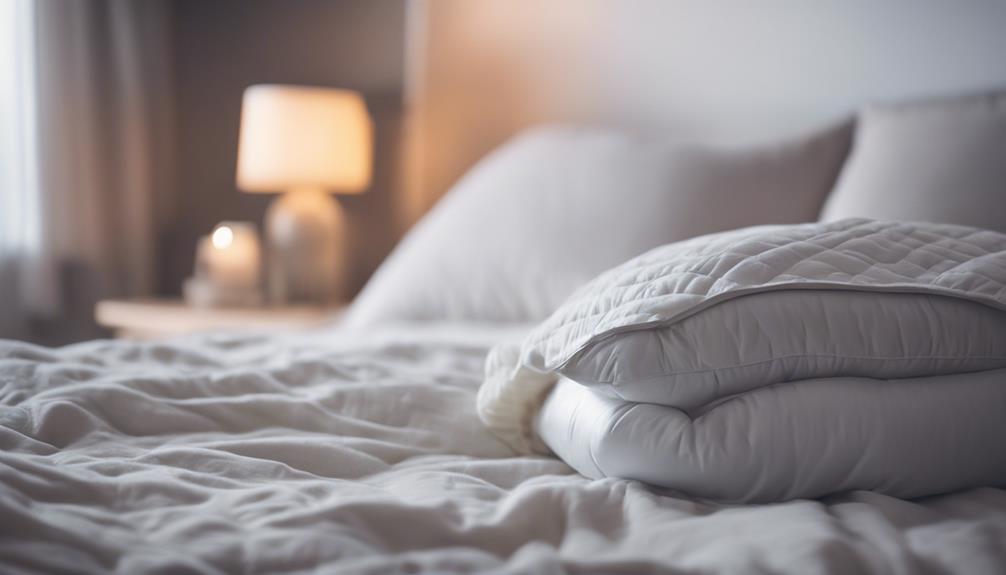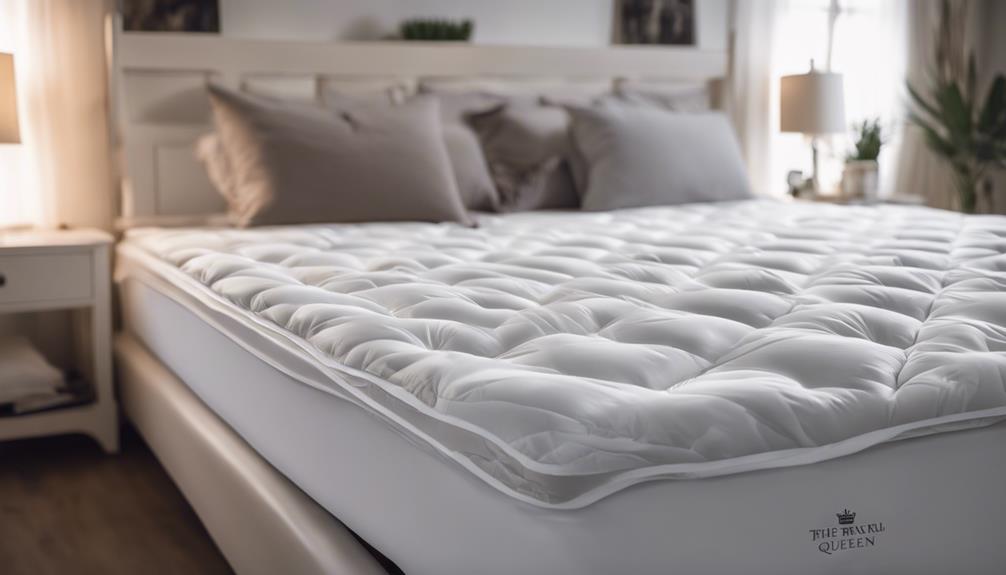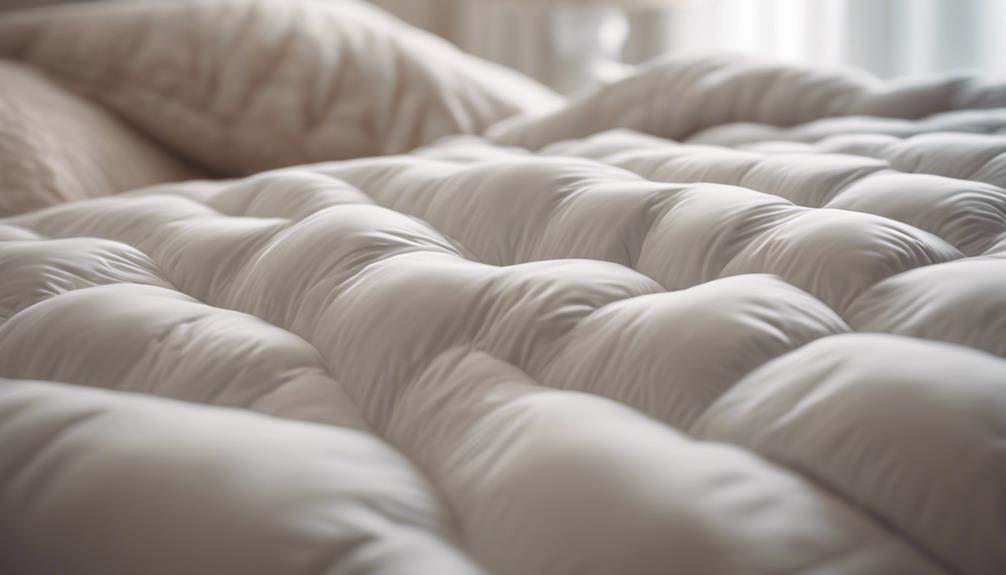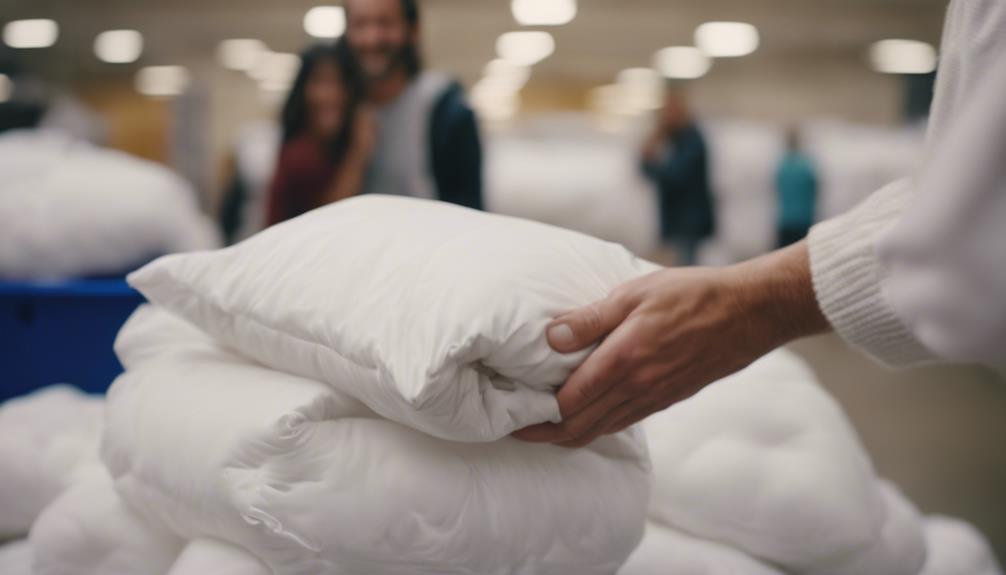Down comforters that are not washed regularly can potentially cause allergies to flare up. Dust mites and mold in unwashed bedding are the main culprits, leading to symptoms such as fatigue and congestion. However, hypoallergenic down comforters have been specially treated to decrease allergens. They utilize barrier fabrics and advanced cleaning methods to create a healthier sleep environment, particularly beneficial for those with sensitivity. These comforters can help reduce allergy triggers while still providing a snug option. For individuals with severe allergies, hypoallergenic bedding or down alternatives are recommended to offer relief and prevent allergic reactions. It’s worth considering the advantages of hypoallergenic properties for a cleaner sleep space.
Key Takeaways
- Hypoallergenic down comforters reduce allergy triggers.
- Special cleaning processes eliminate allergens.
- Barrier fabrics prevent allergen penetration.
- Provide cozy, allergen-free bedding option.
- Suitable for sensitive individuals with allergies.
Allergies Triggered by Down Comforters
Have down comforters been wrongly accused of triggering allergies, or is there a deeper culprit lurking in our bedding?
While down comforters themselves aren't common allergy triggers, the real villains are often dust mites and mold that accumulate in unwashed bedding. Allergies to feathers are actually quite rare, with true allergic reactions to down feathers being uncommon. Symptoms of allergies from down comforters can mimic hay fever, causing fatigue, swelling, and respiratory issues.
To combat these issues, regular washing of down comforters is essential as it helps eliminate dust mites and mold, reducing the risk of allergic reactions. For individuals with severe allergies to dust mites or dander, opting for hypoallergenic bedding or down alternative comforters may be a safer choice. By choosing hypoallergenic bedding, one can enjoy the warmth and comfort of a down comforter without the worry of triggering allergic reactions.
Hypoallergenic Down Comforters Explained

Hypoallergenic down comforters are crafted to reduce allergic reactions through special cleaning processes. These comforters are designed to eliminate allergens like dust mites and dander, making them suitable for sensitive individuals.
With features like barrier fabrics and hyperclean technology, hypoallergenic down comforters provide a cozy option that minimizes allergy triggers.
Down Vs Allergies
When comparing down comforters to allergies, it becomes essential to understand how hypoallergenic options can offer relief to sensitive individuals.
Hypoallergenic down comforters are crafted to minimize allergic reactions by using specially treated down or alternative fillings. These comforters undergo thorough cleaning processes to eliminate allergens such as dust mites and dander.
The inclusion of barrier fabrics acts as a protective layer against allergens, creating a healthier sleep environment for allergy sufferers. By meeting stringent purity standards, hypoallergenic down comforters can reduce potential triggers, making them a suitable choice for those with allergies.
Choosing a hypoallergenic down comforter can provide the warmth and comfort desired without exacerbating allergies, offering a practical solution for sensitive individuals.
Hypoallergenic Features
Crafted with tightly woven fabrics and undergoing specialized cleaning processes, hypoallergenic down comforters are meticulously designed to minimize allergens like dust mites and dander. These products keep allergens at bay by preventing them from penetrating the comforter, offering a safer option for those prone to allergies.
By targeting common triggers such as dander and dust mites, hypoallergenic down comforters provide a cleaner sleeping environment. Through rigorous testing and adherence to purity standards, these comforters reduce the risk of allergic reactions, making them a reliable choice for individuals with sensitivities.
Opting for a hypoallergenic down comforter can provide both comfort and peace of mind for those seeking a bedding solution that prioritizes allergy prevention.
Allergy-Friendly Comforters
Our focus lies on explaining the benefits of allergy-friendly comforters, particularly the effectiveness of hypoallergenic down comforters in creating a safe sleeping environment for allergy sufferers. Hypoallergenic down comforters are designed to minimize allergens like dust mites and dander, making them a great choice for those with allergies. These comforters undergo special cleaning processes to remove potential allergens from the down filling. Barrier fabrics in hypoallergenic down comforters help prevent allergens from penetrating the bedding, offering a cozy and allergen-free option for allergy sufferers. Opting for a hypoallergenic down comforter can provide comfort and warmth without triggering allergic reactions. Consider these alternatives to synthetic materials for a comfortable and allergy-friendly sleep environment.
| Benefit | Description |
|---|---|
| Minimize Allergens | Reduces dust mites and dander in the bedding. |
| Special Cleaning Processes | Removes potential allergens from the down filling. |
| Barrier Fabrics | Prevents allergens from penetrating the comforter. |
| Comfort and Allergen-Free Environment | Offers a cozy and allergen-free bedding option for allergy sufferers. |
Down Comforters Vs. Down Alternatives
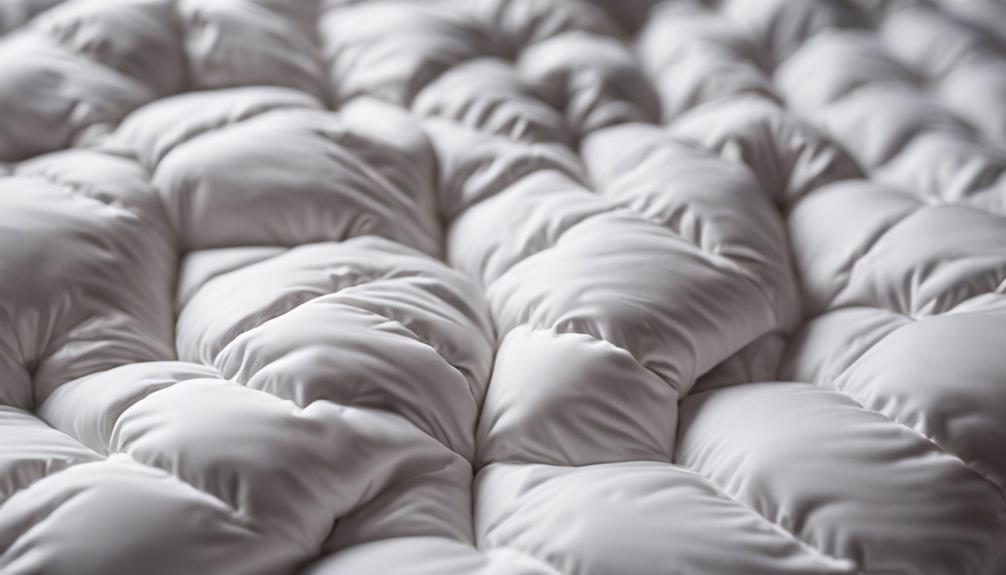
Comparing down comforters to down alternatives reveals distinct characteristics that cater to different preferences and needs. Down comforters are filled with fine feathers underneath ducks or geese outer feathers, giving a luxurious and airy sensation. However, individuals with feather allergies might find these comforters irritating.
On the other hand, down alternatives, made from fibrous materials, mimic the softness of down while being hypoallergenic, making them ideal for allergy sufferers. While real down tends to be pricier and holds more warmth, down alternatives are more budget-friendly and easier to maintain. Although down alternatives may not perfectly replicate the warmth and fluffiness of real down, they offer a suitable option for those with allergies.
When deciding between feather bedding and down alternatives, it's essential to take into account factors like budget, desired warmth level, and allergy concerns to select the most suitable option for your needs.
Managing Allergies With Bedding Choices

When managing allergies with bedding choices, it's vital to prioritize hypoallergenic options to minimize the risk of allergic reactions. Washing the bedding regularly can help remove allergens like dust mites and dander that may trigger allergies.
Opting for hypoallergenic bedding options such as down alternative comforters can also be beneficial for those prone to allergic reactions. While down comforters themselves aren't the primary cause of allergies, proper maintenance and care are essential in reducing the risk of allergic reactions.
Genuine feather allergies are relatively rare, and symptoms may resemble those of hay fever. If you experience severe allergic reactions to down comforters, seeking medical advice is recommended to determine the best course of action.
Tips for Allergy-Free Sleeping Environment
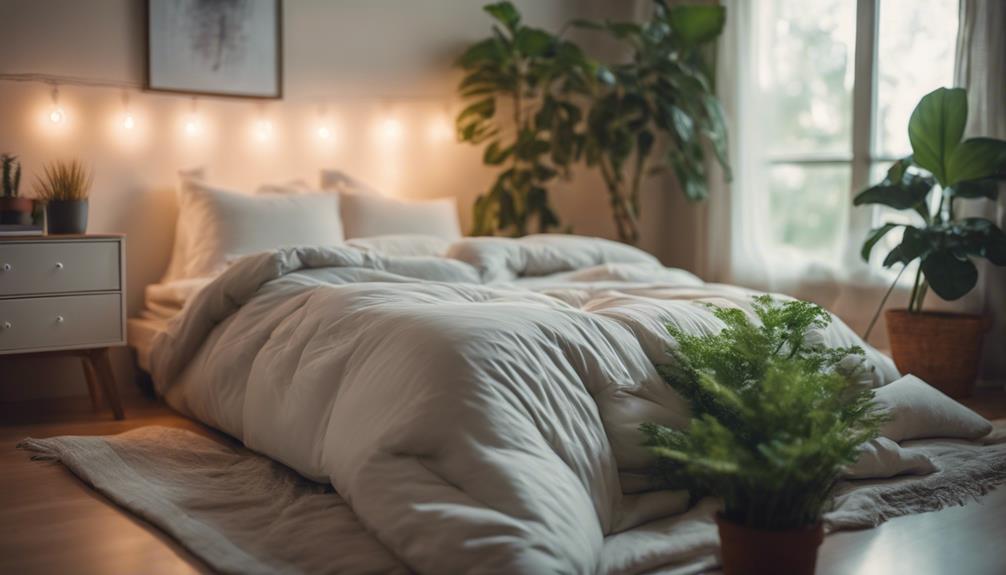
To create an allergy-free sleeping environment, it's important to invest in allergy protection pillows and mattress covers to reduce dust mites and dander in your bedding. These covers act as barriers, preventing allergens from accumulating in your pillows and mattress, thereby minimizing potential triggers for allergies.
When it comes to featherbeds, encasing them with allergy protection covers is essential to avoid allergen buildup. Opt for bedding made with allergen barrier fabric such as Pacific Coast AllerRest, which provides an extra layer of protection against common allergens.
Additionally, keeping stuffed animals clean and off the bed can help minimize allergens in the bedroom, promoting a healthier sleep environment. By maintaining these practices and investing in the right protective bedding materials, you can greatly reduce allergy symptoms and improve the overall quality of your sleep.
Creating an allergy-free sleeping space is key to ensuring restful nights and better health.
Symptoms of Allergies to Down Comforters

When allergic to down comforters, symptoms like sneezing, coughing, and watery eyes may arise. Skin rashes, itching, nasal congestion, and respiratory issues are also common.
Allergy reactions can range from mild discomfort to more severe manifestations.
Allergy Symptoms Overview
Experiencing allergies to down comforters can manifest in symptoms such as a runny nose, coughing, congestion, and a sore throat. These symptoms are often triggered by dust or feathers present in the comforter, mimicking reactions to dust mites. When dealing with persistent allergies to goose down, it may be necessary to switch to hypoallergenic bedding or use antihistamines for relief. In severe cases, unusual reactions like facial swelling, airway closure, or hives may occur, requiring immediate medical attention and avoidance of feather-filled bedding. Below is a table summarizing the common allergy symptoms associated with down comforters:
| Symptom | Description |
|---|---|
| Runny Nose | Excessive nasal discharge |
| Coughing | Persistent coughing fits |
| Congestion | Blocked nasal passages |
| Sore Throat | Irritation and discomfort in the throat |
| Facial Swelling | Swelling of the face due to allergic reaction |
Down Alternatives Comparison
Comparing down alternatives for allergies reveals the suitability of hypoallergenic materials like polyester in comforter production. These alternatives, made with natural materials such as cotton, silk, or wool, offer a cozy sleep experience without the risk of triggering allergies.
Down alternative fibers mimic the softness and loftiness of real down, providing warmth and breathability. For individuals sensitive to down feathers, opting for down alternative comforters can be a safe and effective choice. Not only do these comforters prevent allergy symptoms, but they also maintain the plushness and comfort one expects from a quality bedding option.
Cleaning for Allergies
To effectively manage allergies to down comforters, understanding the symptoms and proper cleaning techniques is essential. Symptoms of allergies to down comforters may include a runny nose, coughing, congestion, and sore throat. These allergic reactions can be triggered by dust mites or feathers present in the comforters.
Remember that feather and dust mite allergy symptoms can overlap, making it challenging to pinpoint the exact cause. While true allergies to goose down feathers are rare, individuals sensitive to dust and dander may still experience persistent reactions.
To help alleviate these symptoms, consider opting for hypoallergenic bedding and regularly clean your down comforters to reduce allergen buildup. Proper cleaning practices play a significant role in managing allergies related to down comforters.
Choosing the Best Bedding for Allergies

How can we ensure that our bedding choices cater to allergy sufferers? When selecting bedding for individuals with allergies, it's important to take into account hypoallergenic options like down alternative comforters. These comforters are designed to minimize allergic reactions by using synthetic materials that are less likely to trigger symptoms. Additionally, proper washing and maintenance of bedding can greatly reduce the presence of allergens such as dust mites and dander. By following care instructions and keeping bedding clean, allergy risks can be further lessened.
To assist in making an informed decision, the table below summarizes key factors to consider when choosing bedding for allergies:
| Factor | Description | Importance |
|---|---|---|
| Material | Opt for hypoallergenic down alternative comforters to reduce allergy triggers. | High |
| Washing Instructions | Follow proper washing and maintenance guidelines to minimize allergen build-up. | Medium |
| Allergy Symptoms | Be aware of common allergy symptoms like runny nose and coughing related to bedding materials. | Low |
Frequently Asked Questions
Should I Get a Down Comforter if I Have Allergies?
We don't recommend down comforters for those with allergies due to potential triggers like dust mites and mold.
Opt for hypoallergenic down alternative comforters to reduce the risk of allergic reactions. Symptoms are often linked to dust mites and dander rather than the feathers themselves.
Proper washing and maintenance can help, but consulting an allergy specialist for personalized advice is wise.
Your comfort and health matter, so choose wisely for a good night's sleep.
What Is the Best Comforter for Allergies?
When considering the best comforter for allergies, it's important to prioritize hypoallergenic features. Look for comforters with allergen barrier fabric to reduce exposure to dust mites and dander.
Down alternative comforters made of synthetic fibers like polyester can also be a good option for severe allergies. Consult an allergist for personalized advice on bedding choices that suit your specific needs.
Prioritize creating a safe sleeping environment to minimize allergen exposure.
Is Goose Down Okay for Allergies?
We find that goose down comforters may trigger allergies in some individuals due to dust mites and mold that can accumulate in the bedding. Symptoms of such allergies typically include a runny nose, coughing, congestion, and a sore throat.
While true allergies to goose feathers are rare, opting for hypoallergenic bedding or down alternative comforters can be a safer choice for those prone to allergies. For severe reactions, seeking medical advice is recommended for proper diagnosis and treatment.
What Bedding Is Best for Allergies?
When it comes to bedding for allergies, options like wool or organic cotton can be great due to their natural resistance to dust mites. Barrier fabrics in allergy protection bedding help keep out allergens, and regular washing can eliminate dust mites.
Down alternative comforters made of hypoallergenic materials provide a plush feel without triggering allergies. Look for bedding with allergy-free certifications for reduced allergen exposure.
Can a Down Comforter Aggravate Allergies in the Summer?
Yes, a down comforter for summer can aggravate allergies due to the potential for dust mites and mold growth in humid conditions. The fluffy filling of a down comforter can trap allergens, leading to sneezing, itching, and breathing difficulties for allergy sufferers during the summer months.
Conclusion
To sum up, when it comes to allergies and down comforters, opting for hypoallergenic options can make a big difference.
By understanding the differences between down comforters and down alternatives, and taking steps to create an allergy-free sleeping environment, you can help alleviate symptoms and enjoy a better night's sleep.
So, next time you're shopping for bedding, keep your allergies in mind and make the best choice for a comfortable and healthy sleep experience.
